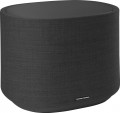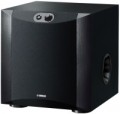Phase inverter location
—
Behind. It is recommended to install subwoofers with a rear bass reflex so that the back of the case, where the bass reflex is located, is away from the wall. If you put such a subwoofer right next to the wall, then the sound quality will be noticeably reduced. Bass reflex subwoofers on the back of the cabinet are usually placed in the centre of the room. If it is not possible to put acoustics in the centre, then they try to place this type of subwoofers away from the wall that the bass reflex is looking at.
—
Front. Front-facing bass reflex subwoofers are good if the acoustics need to deeply reveal the image of low-frequency sound. Acoustics of this type are recommended for music in which there is a lot of bass. The front location of the phase inverter allows you to put the subwoofer almost close to the wall.
—
From below. Bass reflex subwoofers are designed to be hung at a height. In this case, there will be no interference in the path of low-frequency sound, that is, the bass will be revealed as fully as possible. If it is not possible to hang such a subwoofer, then it is permissible to put the acoustics on a high stand. But the stand should not overlap the phase inverter.
—
Sideways. Subwoofers with a side bass reflex can be placed close to the wall and in the corner, but if the corner wall does
...not block the bass reflex. The lateral location of the phase inverter allows acoustics to focus on mid-frequency and high-frequency sound. The low frequency sound will become moderate. This is the optimal acoustic scheme for watching movies.Power
Rated power of the subwoofer. Technically, this is the highest average (rms) sound power at which the device can work normally (without sound distortion and damage to components) for an unlimited time. Simply put, the more powerful the subwoofer, the louder it is. The choice for this parameter depends primarily on the size of the space / room that is planned to be covered; detailed recommendations for different situations can be found in special sources.
Also, the power is directly related to the characteristics of the amplifier used with the subwoofer. For active subwoofers (see "Type"), this item actually indicates the nominal power of the built-in amplifier; the speaker itself can be more powerful, but it doesn't matter anymore. For passive models, the power rating corresponds to the highest amplifier power that can be connected to the speaker without the risk of damaging it at high volume.
Frequency range
The range of audio frequencies reproduced by the subwoofer. As a general rule, the wider the frequency range, the richer the sound and the more detail the speaker can convey. However, it is worth remembering that subwoofers as a class are designed for low and ultra-low frequencies in the range from 20 to 150 (sometimes 200) Hz. Therefore, in fact, a significant difference in sound is noticeable only with a large difference in the reproducible ranges (for example, 20-200 Hz and 50-150 Hz).
Also, do not forget that an extensive frequency range is not yet a guarantee of high-quality sound; and in some cases (for example, if the main speakers of the speaker also cope well with low frequencies), it may be completely redundant.
Speaker size
The diameter of the speaker(s) installed in the subwoofer.
It is believed that the larger the speaker (
15 ",
18 " and more), the more power it can produce and the deeper the bass will be on such acoustics. However, in modern subwoofers, manufacturers use various tricks that allow achieving good sound depth even with relatively small speaker sizes (
10 ",
8 "). Therefore, it is possible to compare different models only if they differ significantly in this indicator; and even then, in such cases, it is worth paying attention not so much to the speaker diameter as to the price category. The golden mean among sizes is
12-inch subwoofers.
Wireless connection
The presence of a
wireless connection in a subwoofer is most often Bluetooth: this standard is practically generally accepted in modern electronics, it is supported by the vast majority of smartphones, tablets and laptops. Note that we can talk about connecting an audio signal, as well as connecting to a device like a smartphone or tablet to manage settings. However, the latter option is not common — mainly in concert models, based on the ability to reconfigure the subwoofer even in a situation where there is no direct access to it.
If we talk about wireless sound transmission, then this option is convenient primarily from the point of view of choosing the optimal installation location: moving the subwoofer around the room, you do not need to mess with wires, and the Bluetooth range reaches 10 m. However, the quality of sound transmission with a wireless connection may be lower than with wired, but for bass this point is not as noticeable as for other frequency bands.
Phase adjustment
The ability to shift the sound produced by the subwoofer in phase — usually by 180 °, but in some models the option is also available by 90 °.
Sound vibrations can be represented as a sinusoid. In some cases, the sinusoids from the subwoofer and from the main speakers may be out of phase — for example, with a difference in distance, inconsistency in the operation of amplifiers, etc. This degrades the sound quality. And
the phase adjustment allows you to correct the situation and coordinate the subwoofer with the rest of the components of the speaker system.
Level adjustment
The subwoofer has its own
level control, in other words, a volume control. Adjusting the bass with such a control is often easier than digging into the settings of an amplifier or other external device.
Adjustable crossover
The presence of an
adjustable crossover in the design of the subwoofer.
A crossover is a device that divides the audio signal into separate frequency bands and directs each band to "its own" speakers. See "Crossover Frequency" for more on this. Here we note that the adjustable crossover allows you to change the upper threshold of the frequencies supplied to the subwoofer. This allows you to optimally match the bass speaker with the main speakers — so that, on the one hand, the bass does not overlap, on the other, there is no gap between the subwoofer and the rest of the acoustics.
Crossover frequency
Cutoff frequency of the crossover installed in the subwoofer (or supplied with it — for passive models, see "Type").
The crossover splits the audio signal into separate frequencies so that only the bass goes to the subwoofer and only the main range goes to the speakers. Such a device is mainly equipped with home models (see above). And the crossover frequency is the upper threshold of the frequencies fed to the subwoofer. This information is important for matching with the rest of the speakers: ideally, the lower threshold of the main acoustics should correspond to the upper threshold of the subwoofer, otherwise the frequencies will either overlap or dip in them (neither of which contributes to sound quality). For the convenience of matching, the crossover can be made adjustable (see above).

